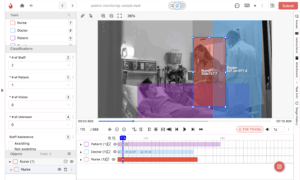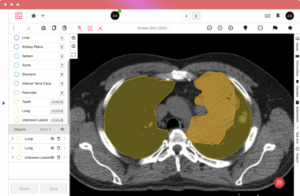In the world of medical AI, precision isn’t a luxury; it’s a necessity. Whether you’re training algorithms to detect anomalies in radiology scans or powering decision-support tools in pathology, the quality of your training data determines the quality of your model. And that starts with accurate medical data annotation.
But annotating medical images isn’t like labeling pictures of cats and dogs. It requires domain expertise, regulatory compliance, customized tooling, and robust human-in-the-loop workflows. That’s why choosing the right annotation tool or service partner can make or break your AI project.
Here are the top 5 tools and services shaping the future of medical data annotation in AI development:
1. iMerit Ango Hub: Enterprise-Grade Platform for Medical AI
iMerit’s Ango Hub is purpose-built for high-complexity medical image annotation projects in radiology, pathology, and beyond. It offers HIPAA-compliant security, full MLOps integration, and support for a wide range of imaging modalities and formats, including DICOM, NRRD, NIfTI, TIFF, and MP4. It’s more than just a tool; it’s a complete ecosystem for clinical-grade data annotation.
What sets Ango Hub apart is its seamless combination of automation, domain expertise, and robust QA. With iMerit’s certified radiologists, pathologists, and trained medical imaging specialists powering the platform, every annotation reflects precision, consistency, and clinical relevance.

Key features:
- Multi-modal image support (CT, MRI, X-ray, ultrasound, histopathology)
- Support for medical file types including DICOM, NRRD, NIfTI, TIFF, and MP4
- Automation-assisted annotation tools to accelerate workflows without sacrificing quality
- AI-assisted pre-labeling and automation pipelines to reduce manual effort while preserving expert control
- Model integration: Use your own or off-the-shelf models for automated annotations as part of the workflow
- Multiplanar functionality: View and annotate studies in axial, sagittal, and coronal planes with consistent segmentation
- Multi-view layout: Screen-right panel supports simultaneous views for comparative labeling and faster review
- 3D Views: Toggle 3D reconstructions to precisely model anatomical structures and improve spatial accuracy
- On-prem, hybrid, or private cloud deployment for secure and compliant infrastructure
- Built-in QA workflows and expert consensus validation
- Real-time reporting and analytics for model training feedback loops
- Fine-grained task routing and reviewer assignment to minimize turnaround time and maximize annotation accuracy
- Workflow assignment to enable multi-annotator reviews and consensus-based labeling
- Sample labels can be used to guide annotators through edge cases and complex examples
- Reviewers can accept, reject, or fix labels with full visibility for quality control
- Real-time issue resolution lets annotators escalate questions directly to project managers
- Performance benchmarks and re-annotation tasks help continuously improve output quality
- Uploadable labeling guidelines keep the entire team aligned and reduce variability
If you’re building a medical AI model that demands more than just labelingmthink clinical context, radiologic workflows, and regulatory readiness iMerit is the partner to consider. Ango Hub delivers expert-reviewed, automation-enhanced, and ML-ready annotations for every stage of your model lifecycle.
2. Encord
Encord supports DICOM, NIfTI, and multimodal medical data workflows, combining AI-assisted labeling with active QA cycles. Academic institutions and healthcare AI teams have adopted it for its rapid iteration and quality control.
Key features:
- Automated error-checking pipelines and consensus scoring
- Multi-user collaboration, role-based controls, and issue tracking for clinical workflows
- Active learning with model-assisted annotation to speed labeling while maintaining accuracy.
Best suited for medical AI teams seeking rapid iteration with strong clinical compliance.
3. Cogito Tech
Cogito Tech, in partnership with RedBrick AI, offers clinical annotation services with board-certified annotators across radiology, cardiology, oncology, and surgical imaging. Their managed workflows emphasize compliance and accuracy for healthcare datasets.
Key Features:
- Clinical-grade annotation support (segmentation, classification, video frames)
- Workflows covering DICOM, NIfTI, pathology slides, and endoscopic video
- HIPAA and FDA‑ready infrastructure
- Expert escalation and QA pipelines
Best for healthcare AI teams that prefer managed services with certified clinical reviewers and full workflow oversight.
4. SuperAnnotate
SuperAnnotate brings an automation-first approach to medical image annotation, making it ideal for high-volume datasets like digital pathology and ultrasound. Originally built for general computer vision tasks, it now supports medical imaging with flexible plugin support and rapid AI-assisted tooling.
Key Features:
- AI-assisted segmentation and mask propagation
- Custom ontology builders and tagging rules
- Plugin-style support for DICOM and pathology formats
- Flexible deployment (cloud or on-premise)
SuperAnnotate is a strong fit for AI-first teams that prioritize speed and iteration, especially in early-stage projects, before layering in expert validation and QA.
5. MD.ai: Designed for Clinical Radiology Projects
MD.ai is a popular choice among research institutions like the NIH and Stanford for its radiology-focused workflows and collaborative annotation features. Its PACS-style interface, native DICOM support, and adjudication tools make it well-suited for pilot projects, peer-reviewed datasets, and clinical research that require multi-reader validation and structured reporting.
Key features:
- Native DICOM support with PACS-like viewing
- Multi-reader workflows with adjudication and consensus
- Structured reporting for clinical research alignment
- Model inference overlays to support active learning
While MD.ai isn’t built for large-scale production workflows, its strengths in radiology collaboration and academic-grade research make it a top choice for clinical-grade model evaluation and annotation projects.
Choosing the Right Tool: Why Expertise Still Matters
Even the best annotation platform is only as good as the people using it, especially in medicine, where the margin for error is razor-thin. Automated tools can accelerate labeling, but clinical insight, expert review, and quality assurance are irreplaceable.

That’s where iMerit stands out: combining a robust platform, Ango Hub, with domain-trained medical professionals and scalable project management. Whether you’re training a model to detect lung nodules, segment tumors, or analyze retinal scans, iMerit ensures your data is accurate, secure, and ML-ready.
Conclusion
Medical AI is only as strong as the data it learns from. As the bar for clinical safety, accuracy, and compliance rises, choosing the right annotation platform becomes mission-critical. Whether you’re a research team, startup, or enterprise AI developer, these tools and the experts behind them will shape your success in 2025 and beyond.
Looking to scale your medical AI with precision-labeled data?
Discover how iMerit’s Ango Hub and expert services can assist you. Learn more
